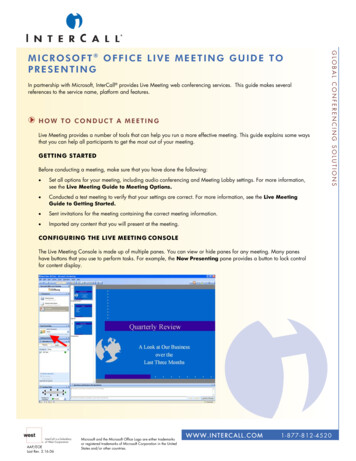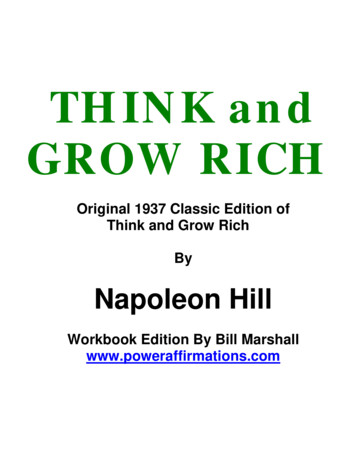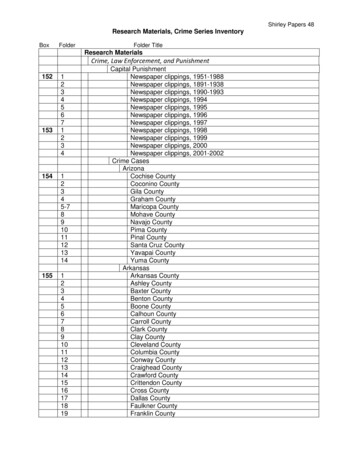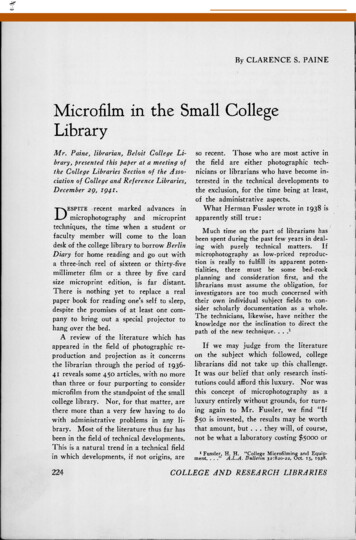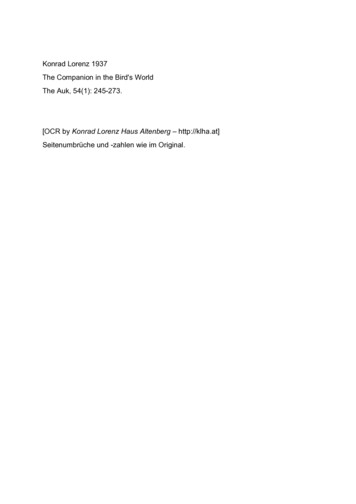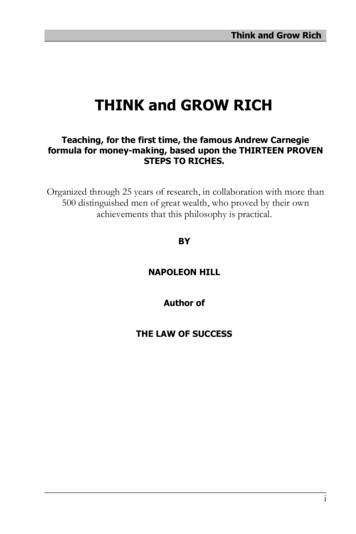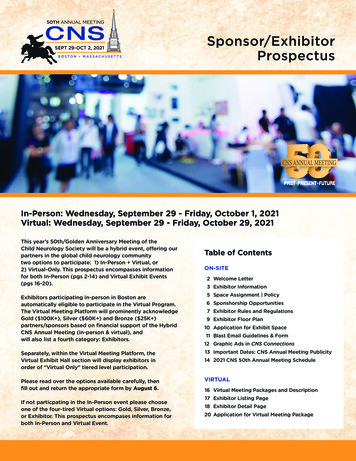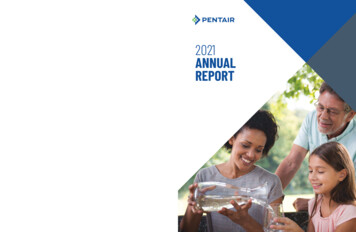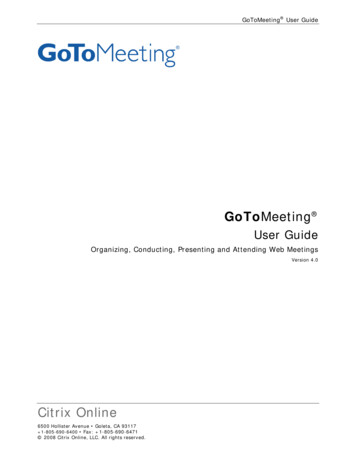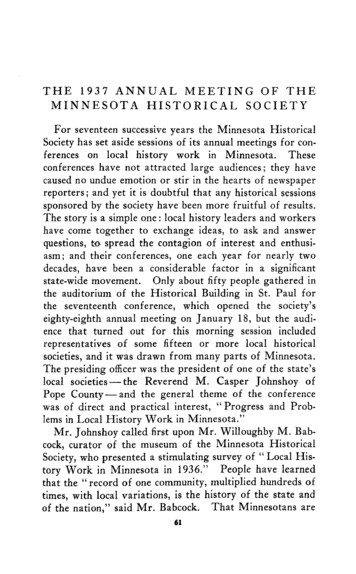
Transcription
T H E 1937 A N N U A L M E E T I N G O F T H EMINNESOTA HISTORICAL SOCIETYFor seventeen successive years the Minnesota HistoricalSociety has set aside sessions of its annual meetings for conferences on local history work In Minnesota. Theseconferences have not attracted large audiences; they havecaused no undue emotion or stir In the hearts of newspaperreporters; and yet It is doubtful that any historical sessionssponsored by the society have been more fruitful of results.The story is a simple one: local history leaders and workershave come together to exchange ideas, to ask and answerquestions, to spread the contagion of Interest and enthusiasm; and their conferences, one each year for nearly twodecades, have been a considerable factor in a significantstate-wide movement. Only about fifty people gathered Inthe auditorium of the Historical Building in St. Paul forthe seventeenth conference, which opened the society'seighty-eighth annual meeting on January 18, but the audience that turned out for this morning session includedrepresentatives of some fifteen or more local historicalsocieties, and it was drawn from many parts of Minnesota.The presiding officer was the president of one of the state'slocal societies — the Reverend M. Casper Johnshoy ofPope County — and the general theme of the conferencewas of direct and practical Interest, " Progress and Problems in Local History Work in Minnesota."Mr. Johnshoy called first upon Mr. Willoughby M. Babcock, curator of the museum of the Minnesota HistoricalSociety, who presented a stimulating survey of " Local History Work in Minnesota In 1936." People have learnedthat the " record of one community, multiplied hundreds oftimes, with local variations, is the history of the state andof the nation," said Mr. Babcock. That Minnesotans are61
62THE ANNUAL MEETINGMARCHrapidly learning this lesson and are organizing for the studyand preservation of local backgrounds was graphically illustrated on a map of the state presented by the speaker.Blocked off in colors were the counties and communitieshaving local historical organizations, and it was gratifyingto note that they occupy well over half the area of the state.Three of the societies Indicated on the map, in Chippewaand Morrison counties and in the village of Cass Lake,were organized In 1936, according to Mr. Babcock; asociety has been planned in Yellow Medicine County; andsigns of interest are evident In Grant and Kittson counties."Active, energetic leadership by younger business and professional men and women" was characteristic of the localhistorical movement in 1936, according to Mr. Babcock.Under the new leadership, membership campaigns havebeen conducted by several societies with notable results.The Winona County Historical Society, for example, reports 255 members at the end of Its first year of activity.Among the evidences of Interest in local historical workdescribed by the speaker were the publication in communitynewspapers of numerous articles furnished by local historians, the presence of as many as ten thousand people atsummer meetings sponsored by local societies, and the establishment of county and community museums for the preservation of historical material assembled by local workers.The part played by the W P A in forwarding the latter typeof activity was stressed by the speaker, who mentioned theinterest of the state historical society In local museum projects and announced its willingness to co-operate in the work.The supervisor of the Stearns County museum project.Miss Marjory D. Carter of St. Cloud, followed Mr. Babcock on the program. She took as her subject " Interviewing the Pioneer and Writing His Biography," telling howto locate pioneers who might be interviewed, how to gaintheir confidence, what types of questions to ask, and the like.She suggested that an interviewer "gather from every
1937THE A N N U A L MEETING63available source all the information that can be found aboutthe pioneer, his family, work, and interests " before starting an interview, that this information should be verifiedduring an interview, that leading rather than direct questions should be used, and that questions should " suit theexperiences of the Individual pioneer." Included in thenotes made by an interviewer, said Miss Carter, should beHsted the " pictures, museum articles, diaries, plats, letters,and other historical papers " in the possession of the pioneer, and any Information about people and places that canbe gleaned from birth certificates, marriage licenses, andfamily Bibles. She also made the Interesting suggestionthat " dates of births, marriages, and deaths, and locationsand dates of claims or homesteads should be checked againstrecords in the county courthouse."After thanking Miss Carter for her practical suggestions,the chairman called upon Mr. Ralph D. Brown of Minneapolis for a discussion of " Problems in the HistoricalRecords Survey," of which he Is state director. He reminded the audience that the survey was inaugurated inDecember, 1935, as a WPA project under the sponsorshipof the Minnesota Historical Society. The program of historical work undertaken by the survey included the makingof inventories of public records In Minnesota, papers oforganizations and business concerns, manuscript materialsin public and private hands, and the holdings of local historical societies; and the listing of churches, cemeteries,monuments and markers, historic buildings, historic trails,and historic sites. Mr. Brown presented figures to showwhat had been accomplished In carrying out this program.As a result of the survey, he said, many additions have beenmade to the collections of the state historical society. Hepointed out that In connection with this work, excavationsat Grand Portage and at old Fort Ridgely had been supervised, and the storage space for archives in every courthouse in the state had been examined. The final speaker
64THE ANNUAL MEETINGMARCHon the morning program, Mrs. Sara D. Boyce of St. Paul,described the relation between "Minnesota Census Recordsand Old Age Assistance." Since last April Mrs. Boyce hasbeen employed by the old age assistance department tolocate the names of appHcants in the manuscript censusschedules preserved by the Minnesota Historical Society.The record of age In the census Is accepted by the department in cases where the eligibility of an applicant is open toquestion. In the course of her work Mrs. Boyce hassearched for more than seven thousand names and has successfully located some four thousand.The general discussion which followed the formal program was opened by Mr. Johnshoy, who told somethingabout the work of the Pope County Historical Society andIts co-operation with the WPA. He distributed amongmembers of the audience copies of a questionnaire used byworkers engaged in a survey of Pope County schools, andhe announced that records had been assembled for sixty outof the eighty-three school districts In the county, and thearchives of more than forty turned over to the society forpreservation. Similar surveys of health work, medicalpractice, nursing, and hospitals In the county are under way,according to Mr. Johnshoy. Upon the conclusion of hisremarks. Dr. Theodore C. Blegen, superintendent of theMinnesota Historical Society, rose to call attention to thefact that the forty-nine local historical organizations shownon the map presented by Mr. Babcock had come Into beingsince 1922, that "substantially our county historical movement is a thing of the last fifteen years." He mentionedthe section devoted to "Local Historical Societies" that isnow appearing regularly In M I N N E S O T A HISTORY and hesuggested the possibility of " some kind of bulletin of notesand information about local work." Among local leaderswho spoke were Mr. Martin Widsten of Bemidji, MissCarter, and Judge Julius E. Haycraft of Fairmont. Theadvisability of preserving historical material in log cabins
1937THE A N N U A L MEETING65was under discussion, and Judge Haycraft called attentionto a log building which had served as the first post officeIn Watonwan County and was now preserved in Madelia." I t is hardly suitable for a permanent place for recordsand I think it is not so intended," he said. For that purpose the Watonwan County Historical Society uses a roomin the courthouse.The annual luncheon of the society, which was held atthe St. Paul Athletic Club at 12:15 P.M., was attended byabout a hundred and fifteen of its members and friends.It was followed by a program of talks and papers, withSenator Victor E. Lawson, editor of the Willmar Tribune,presiding. The first speaker, Mr. Edward C. Gale ofMinneapolis, president of the society, announced as his subject " M y Father's Diary, 1858-65." Many intimateglimpses of life and conditions in frontier Minneapolis wererevealed In the extracts from this journal read by Mr. Gale,for his father, Samuel C. Gale, settled In the pioneer community in the summer of 1857 and for many years kept adetailed record of events there. An Idea of the effect ofthe panic of 1857, for example, is given in the entry forJuly 25, 1858, which reads: "Times here are exceedinglyhard. Very little business Is done except by ' dicker.' " Itwas not until the spring of 1858 that the diarist, after commenting upon the Increase in immigration, remarked: " Ithink our people are feeling a little more hopeful." Theslavery issue received considerable attention. On July 30,1860, Gale recorded that "some 15 or 20 slaves, servantsof visitors " from the South were to be found at one localhotel. " One escaped from his mistress last week," herecords, " but was caught and smuggled off down to slaveland — all contrary to our law, of course. Our policytouching these slaves Is to let them alone but if they of theirown will once seek and obtain their liberty and desire tokeep it not the powers of Hell even shall prevail to use usto help capture them." Records of Civil and Sioux war
66THE ANNUAL MEETINGMARCHbattles are frequently encountered in the entries for theearly sixties. In the fall of 1862 the diarist noted that" white settlers throughout the State are in a panic. Evenin Hennepin County nearly half the settlers have left theirhomes and rushed to Minneapolis and beyond . . . yet Icannot learn that an Indian has been seen within ninetymiles of this town.""Old Fort Ridgely as Revealed by the Spade" was thesubject discussed by the next speaker, Mr. G. Hubert Smithof Minneapolis, who was in charge of excavations on thesite of this Minnesota Valley fort made late in the fall bythe Minnesota Historical Society in co-operation with theMinnesota state park division of the National Park Service." W o r k at Fort Ridgely was greatly facilitated," said Mr.Smith, because "Information on the general location ofbuildings, their various construction, and, in several cases,even their original appearance was available." He toldof discovering the foundation lines of the more Importantbuildings that once constituted the fort, including the barracks, the commissary, three officers' quarters, the surgeon'squarters, a bake house, and a hospital. Brick fireplaces,chimney bases, and doorways were located, and hundredsof objects that were lost or discarded before the fort wasabandoned in 1872 were found, the speaker reported. Heannounced that plans are being made to place guard railsaround the foundation walls and cellars when the excavations have been completed, to landscape the site, and to preserve it as a state park.In explaining how " A Novelist Looks at History," Mrs.Darragh Aldrich of Minneapolis, the final speaker on theprogram, declared that "if the novelist has done his workwell, he has produced a story that may have no foundationwhatever in fact but reflects truth even more accuratelythan history." Mrs. Aldrich, who is a well-known writerof fiction, admitted, however, that the modern novelist" draws the very breath of his life from history," that " In
1937THE A N N U A L MEETING67order to find any significance in the present he must studythe past." In concluding her talk she announced that " W ewho are Minnesota novelists are honestly trying to give truepictures of life here — past and present — pictures of significance and possibly distinction. And it Is we who realizemost clearly the infinite value of the work of the MinnesotaHistorical Society. Without Its ' facts,' we should be unable to present Truth." Mrs. Aldrich's interesting talkwas the fifth in a series of professional and business people'sviews of history discussed before the society. Since 1933,when the series was inaugurated, a judge, a business man, ajournalist, a doctor, and now a novelist have presented theirreactions to the subject.The president of the society, Mr. Gale, called the afternoon session to order at 3:00 P.M. In the Historical Building. About fifty people were present. After the readingof annual reports by the treasurer of the society, Mr.Everett H . Bailey of St. Paul, and by the superintendent,Mr. Blegen, a letter from Mr. Charles Stees, a member ofthe society's executive council, was presented to the audience. " It has been a pleasure to serve the Historical Society for over fifteen years as Auditor," wrote Mr. Stees," and never to have found an error in the accounts of ourTreasurer, Mr. Everett H . Bailey. The Society owes Mr.Bailey a vote of thanks for his long and faithful services."A rising vote in appreciation of Mr. Bailey's devoted serviceto the society followed.Two historical papers were read after the close of thebusiness session. The first, presented by Miss GertrudeW. Ackermann, assistant curator of manuscripts for thesociety, dealt with the career of a picturesque figurein early Minnesota — "George W. Northrup, FrontierScout." She drew upon a collection of Northrup's lettersin the possession of the Minnesota Historical Society forthe story of this venturesome youth, who left his home inNew York state in 1853 and went to Minnesota and the
68THE ANNUAL MEETINGMARCHWest. There he worked for a St. Paul fur trader, taughtIn a mission school at Pembina, hunted buffaloes on theplains, served as government farmer for the Indians at Yellow Medicine, joined the Union army for Civil War service,went to the upper Missouri with Brackett's BattaHon, and,when he was but twenty-seven years of age, met his deathIn a battle with the hostile Sioux. Miss Ackermann's paperwill be pubHshed in a future Issue of MINNESOTA HISTORY.In the present issue appears the second paper presented atthis session—"A Footnote on Fire Steels" by Milo M.Quaife, secretary and editor of the Burton Historical Collection at Detroit, Michigan. In Dr. Quaife's absence, hispaper was read by Mr. Babcock.The closing session, held In the evening at the HistoricalBuilding with an audience of approximately a hundred people present, was marked by a challenging and timely annualaddress. Dean Guy Stanton Ford occupied the chair andIntroduced the speaker. Dr. Robert C. Binkley, professorof history In Western Reserve University and chairman ofthe joint committee on materials for research. Dr. Binkley grappled with a big theme, "History for a Democracy," and In his treatment of it he ranged over broad fieldsof history in a probing, questioning, appraising, and distinctly modern spirit. The discussion came to a head inhis analysis of the potential role of family and local history In American democracy and In his conclusions withreference to new ways of making historical narratives oflimited appeal available at nominal prices to those interested. The address goes to a wider audience through itspublication In full In the present issue of this magazine.After the conclusion of Professor Binkley's discussionmany members of the audience lingered In the museumrooms to view the society's varied exhibits. Ten miniaturehistorical groups made by W P A artists aroused much interest, as did a collection of objects unearthed during therecent excavations carried on at the site of Fort Ridgely.
Copyright of Minnesota History is the property of the MinnesotaHistorical Society and its content may not be copied or emailed tomultiple sites or posted to a listserv without the copyright holder’sexpress written permission. Users may print, download, or emailarticles, however, for individual use.To request permission for educational or commercial use, contact us.www.mnhs.org/mnhistory
was of direct and practical Interest, " Progress and Prob lems in Local History Work in Minnesota." Mr. Johnshoy called first upon Mr. Willoughby M. Bab cock, curator of the museum of the Minnesota Historical Society, who presented a stimulating survey of " Local His tory Work in Minnesota In 1936." People have learned



